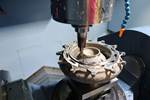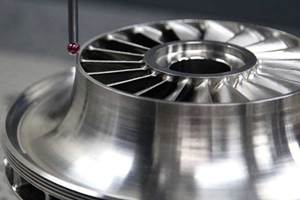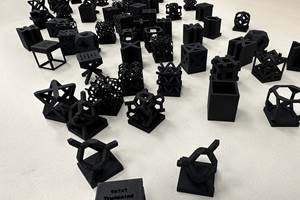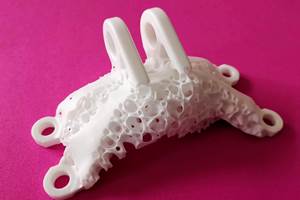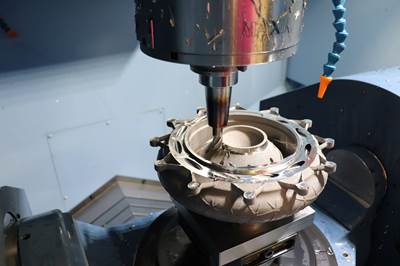Success With AM Involves Not Just the Part but Also Its Purpose
The founder of Keselowski Advanced Manufacturing says additive makes the conversation with the contract manufacturer different from the beginning.
Share
Read Next
Brad Keselowski, founder of Keselowski Advanced Manufacturing (KAM), says there is one vital question that needs to be answered, and deserves to be covered comprehensively, at the beginning of every additive manufacturing job.

Brad Keselowski (facing the camera) is founder of additive manufacturing provider Keselowski Advanced Manufacturing. “We encourage people who come to us: Don’t think of it as an additive journey, think of it as a solution journey,” he says. Photo: KAM.
KAM is a provider of additive manufacturing for production of high-value parts, largely in aerospace. In a recent article, we described how this work integrates with capabilities familiar to conventional manufacturers, notably CNC machining, though the application and even the rhythm is different when AM is the context.
In other words, additive changes the flow of how part-making proceeds.
The question he says needs to be answered carries this same theme even farther. That question is this: What do you want the part to do?
If that question is unanswered, then AM is likely to be a poor choice, Keselowski says.
Indeed, that question marks the very point of departure for additive. There are plenty of manufacturers who make parts to specifications without knowing what the part is or does. Machining providers, for example, excel at this. For the best of them, a complete model or print offers all the information they need. The reason is that the manufacturing process has already dictated to the designer what forms and features are the most producible — to the extent that process rather than purpose has the final say.
By contrast, additive, which is limited by far fewer geometric constraints, needs the purpose in order to guide the outcome.
“If someone comes to us with a model and asks us to just ‘print this,’ then we will look for something more,” Keselowski says. Print this is a recipe for failure. “Something about the part just won’t fit or won’t work,” he says, due to some aim or expectation that was not seen or expressed. The resulting part might prove to be unnecessarily expensive; it might be hindered by a material choice not ideal for the design; or it might present challenges at the points of assembly to parts that ought to be made additively as well.
A part is an idea as much as anything. The promise of additive is that the idea might be realized fully. A bracket, for example, potentially does more than just hold one component in place relative to another. Ideally it also does so at a certain mass, below a certain cost, above a certain stiffness, and with a certain ease of assembly. AM can potentially deliver all the needs and hopes, provided they can be defined. In additive (as in life?) the first step to getting what you want is knowing what you want.
“A model simply given to us to produce additively is going to be underspecified in some ways and overspecified in others,” Keselowski says. It will miss opportunities for streamlining the part’s form and cost to the need.
If a manufacturer such as KAM is not equipped with the role and purpose of a part likely to be made additively, “then we don’t really know what performance is expected of it,” he says. “That means we don’t know the quality requirements.”
In fact, additive might not even be the path. “We encourage people who come to us: Don’t think of it as an additive journey, think of it as a solution journey,” he says. There will be iteration, he notes — a process of discovering all the aims for the part, including those that have not yet been fully seen or stated. Some other process, perhaps machining alone rather than machining as part of additive, might prove to be the best way to realize these aims. Additive expands what is possible in the final solution, but that is all the more reason to focus on the solution. Locking in on AM from the outset actually tends to result in AM being poorly applied.
Related Content
Velo3D Founder on the 3 Biggest Challenges of 3D Printing Metal Parts
Velo3D CEO and founder Benny Buller offers this perspective on cost, qualification and ease of development as they apply to the progress of AM adoption in the future.
Read MoreVixiv Developing AI Alternative to Generative Design
Newly opened Ohio facility is where geometric cells are made and tested to inform the machine learning system that will “know,” without computation, what 3D printed form satisfies a given set of needs.
Read MoreSpherene Creates Metamaterial with Geometry Derived from Spheres
An algorithm developed by Spherene Inc. generates Adaptive Density Minimal Surfaces (ADMS) as a self-supporting infill strategy that can be used to reduce mass and manage material properties in 3D printed parts.
Read More3D Printed "Evolved Structures" for NASA Exoplanet Balloon Mission: The Cool Parts Show #61
Generative design creates stiff, lightweight brackets for EXCITE mission monitoring planets orbiting other stars. The Cool Parts Show visits Goddard Space Flight Center.
Read MoreRead Next
Additive Manufacturing Is Subtractive, Too: How CNC Machining Integrates With AM (Includes Video)
For Keselowski Advanced Manufacturing, succeeding with laser powder bed fusion as a production process means developing a machine shop that is responsive to, and moves at the pacing of, metal 3D printing.
Read MoreProfilometry-Based Indentation Plastometry (PIP) as an Alternative to Standard Tensile Testing
UK-based Plastometrex offers a benchtop testing device utilizing PIP to quickly and easily analyze the yield strength, tensile strength and uniform elongation of samples and even printed parts. The solution is particularly useful for additive manufacturing.
Read MoreCrushable Lattices: The Lightweight Structures That Will Protect an Interplanetary Payload
NASA uses laser powder bed fusion plus chemical etching to create the lattice forms engineered to keep Mars rocks safe during a crash landing on Earth.
Read More

